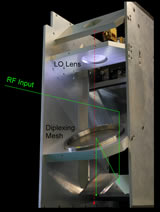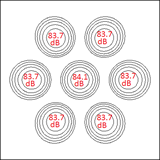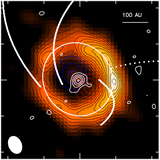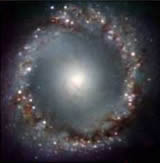Publication > Research Gallery > SMA
Research Gallery
The Submillimeter Array
 |
The Magnetic Field Revealing the Inflow Structures in the Central 2 pc of the Galactic Center (a) and (b): Color-composite image of SMA HCN(J = 4−3) tracing the circumnuclear disk in the Galactic center (blue; CND) and the 6 cm map tracing the mini-spiral (red). The ...(more) |
 |
Photo of wSMA 350GHz band OMT The photo-type of planar orthogonal-mode-transducer for wSMA 350 GHz band. The microstripline is fabricated on 25 um thick Si substrate. The size of ring structure is 200 um. ...(more) |
 |
The performance of wSMA 240 mixer Top: The wSMA240 mixer chip. Three SIS junctions are connected in series for increasing the IF bandwidth. Bottom: The performance of wSMA240 mixer. The DSB noise receiver temperature of wSMA240 ...(more) |
 |
A Spiral and Bipolar Outflow in CIT 6: Unwinding the Mysteries of a Carbon Star Spiral-shell circumstellar pattern of CIT 6 is revealed in our SMA CO J=2-1 channel maps, in blue, shown atop the earlier VLA HC3N J=4-3 (Claussen et al. 2011) in red. ...(more) |
 |
Correlator 1st Down Converter Wideband Upgrade, SMA Project Photo of upgraded Correlator 1st Down Converter (C1DC) unit. This upgrade consisted of increasing the intermediate frequency (IF) signal bandwidth from 4-6 GHz to 4-16 GHz while maintaining the current ...(more) |
 |
RF Block Down Converter Chassis, SMA Project Internal photos of Block Down Converter instrument: left - top view of RF brackets (x4), and monitor & control; right - bottom view of DC power supplies (x4), local oscillator ...(more) |
 |
The SMA antenna built in Taiwan. The SMA antenna built in Taiwan. ...(more) |
 |
The SMA successfully imaged the thermal dust emission at 0.85 mm from the 0.9 x 0.3 pc area of Orion Molecular Cloud-3 (OMC-3), which is located to the north of Orion nebula M42 Left: Filamentary structure observed in the Orion Molecular Cloud obtained in the 850 µm continuum emission taken with the JCMT/SCUBA (Johnstone & Bally 1999) Right: SMA 850 µm continuum image ...(more) |
 |
New Generation SMA 300GHz Receiver One of the two SMA wideband 300GHz receiver inserts from ASIAA. This is a new generation receiver with wider IF operation frequency from 4GHz to 12GHz. This receiver has shown ...(more) |
 |
SMA optical insert This is the new optical insert for SMA receiver. The local oscillator source is fixed on a 3-axes translation stage on the upper section of optical insert. Fine tune this ...(more) |
 |
Co-polarization radiation pattern of the 7-pixel array receiver optics design for SMA SMA 7-pixel array receiver co-polarization radiation pattern at 345 GHz. The peak value of each pixel is indicated. Each contour is 3dB apart. ...(more) |
 |
CRL 618 Gray image is the HST image in Ha, showing multiple optical outflow lobes expanding away from the central star. Color image shows the fast CO bullets inside the lobes, detected ...(more) |
 |
Nature-CenA-COmosaic Left: Optical image of Centaurus A (ESO/IDA/Danish 1.5 m/R. Gendler, J.-E. Ovaldsen, & S. Guisard, ESO). Prominent dust lane is clearly visible. Right: Molecular gas (CO J = 2-1) observed ...(more) |
 |
The SMA, built at the top of Mauna Kea with an altitude about 4000 meters in Hawaii. The SMA, built at the top of Mauna Kea with an altitude about 4000 meters in Hawaii. (Picture Credit: Sergio Martin) ...(more) |
 |
Array receiver optics design for SMA To increase the mapping speed of the Submillimeter Array (SMA), a focal plane array receiver is considered. The optics for a 7-pixel receiver at around 350 GHz were designed using ...(more) |
 |
Direct Imaging of a Compact Molecular Outflow from a Very Low-luminosity Object Blueshifted and redshifted outflow components obtained in the CO (2-1) emission with SMA (this work), superposed on the infrared reflection nebula obtained in the 4.5 um image with Spitzer/IRAC (Bourke ...(more) |
 |
Dust continuum and polarization from envelope to cores in star formation: a case study in the W51 North region SMA observational results of the dust continuum emission at wavelengths of 870 micron (color scales and contours) and the magnetic field projected in the plane of sky (shown in segments). ...(more) |
 |
Antenna Hoffman Enclosure Cooling Cover, SMA Project Photo of modified Hoffman enclosure cover with inlet fan at top and exhaust fan at bottom. The four smaller internal fans were oriented to circulate air within the enclosure in ...(more) |
 |
The circumstellar disk of AB Aurigae: evidence for envelope accretion at late stages of star formation? Left panels: 12CO 2-1 integrated intensity map (M0, upper-left panel) and the velocity dispersion map (M2, lower-left panel) toward the circumstellar disk of the Herbig Ae star AB Aurigae from ...(more) |
 |
Sub-arcsecond images of the protostellar jet from L1448C(N) The SiO J=8-7 and CO J=3-2 images of the jet driven by the class 0 protostar, L1448C(N), observed with the SMA at a resolution of ~0.5". The blue and red ...(more) |
 |
Magnetic Field Strength Maps Local magnetic field strength with the polarization - intensity gradient method: the molecular cloud core W51 e2, SMA extended array data (Tang et al. 2009, Koch et al. 2012). ...(more) |
 |
Global Contraction vs. Hierarchical Fragmentation of the Filamentary Giant Molecular Cloud The filamentary GMC undergoing hierarchical fragmentation will eventually form clusters of OB stars, as traced by the compact 8 μm and the 24 μm emission (Fig. A). The highest mass ...(more) |
 |
The Discovery of the Youngest Molecular Outflow Associated with an Intermediate-mass Protostellar Core in Orion The discovered outflow lobe size (~1000 AU; left panel of the figure) is the smallest molecular outflow ever found in the intermediate-mass protostellar cores. The line width dramatically increases downstream ...(more) |
 |
A Keplerian Circumbinary Disk around the Protostellar System L1551 NE (TOP) Near-Infrared composite color image of L1551 NE observed with SUBARU (Hayashi & Pyo 2009). The blue, green, and red colors are assigned to the H, [Fe II], and H2 ...(more) |
 |
Spatially Resolving Substructures within the Massive Protostellar Envelope in Orion Highest angular resolution achieved with the SMA 850 micron continuum observations has revealed detailed spatial structures within a massive protostellar envelope, MMS 6.The observing data and detailed model comparisons clearly ...(more) |
 |
200GHz Wide-IF mixer Mixer chip and its performance of wide-IF mixer for 200GHz SMA receiver. ...(more) |
 |
SMA observations of GOODS850-11 and GOODS 850-13. First examples of Multiple Submillimeter Sources Resolved by Interferometer Ultradeep multiwavelength images of the submillimeter galaxies GOODS 850–23 (top) and GOODS 850–13 (bottom). Left – 0.88 mm continuum images observed with the SMA. Middle – False color optical images ...(more) |
 |
High resolution map of Seyfert 1/ starburst ring galaxy NGC 1097 Left - CO(J = 2-1) integrated map (contours) overlaid on the archival HST I-band image (color). Right - HST NICMOS Pa α line image (color) overlaid on the CO(J = ...(more) |
 |
Shaped B field lines in the massive star-forming region Orion BN/KL B field map (red-segments) inferred from the polarization of thermal dust emission at 870 micron (black contours) is shown. The asterisk, star, cross and plus mark the position of BN, ...(more) |
 |
Detection of Multiple Bipolar Flows in NGC 7027 with SMA Left - HST (optical and infrared) images of NGC 7027. Magenta is molecular hydrogen (H2) line emission. White is H-alpha (nebular line). Courtesy HSTScI. Right - False color-scale image of ...(more) |
 |
The Reflection-Symmetric Wiggle of the Young Protostellar Jet HH211 The HH211 molecular jet imaged with the SMA at 0.3” resolution. The CO, SiO, SO, and 0.85 mm continuum are red, green, blue, and orange (contours), respectively . ...(more) |
 |
Magnetic field structure of Orion BN/KL Left - Maps of magnetic field in OMC1 region observed with the CSO at 0.35 mm (red) and 0.45 mm (blue). Continuum intensity at 0.35 mm is shown as black ...(more) |
 |
The central region of the Seyfert 1 galaxy NGC 1097 The central region of the Seyfert 1 galaxy NGC 1097 mapped with the SMA in 12CO(2-1) (lower-right image). NGC 1097 is a nearby galaxy with a large-scale bar (left image), ...(more) |
 |
eSMA Optical Fiber Switch, SMA Project Top photo - eSMA control panel consisting of DC power supply, ADAM-6050 monitor and control module, and custom logic board. Bottom photo - Single-mode fiber splice trays with two black ...(more) |
 |
Two SMA antennas built in Taiwan Two SMA antennas built in Taiwan. ASIAA has delivered receiver systems with three bands of 230 GHz, 345 GHz, and 690 GHz. ...(more) |
 |
The Submillimeter Array The Submillimeter Array, built at the top of Mauna Kea (el~4000 m), Hawaii ...(more) |
 |
The HCO+(3–2) line emission at 267 GHz observed with the SMA in the young planetary nebula NGC 7027 The HCO+(3–2) line emission at 267 GHz observed with the SMA in the young planetary nebula NGC 7027 (Huang, Trung, Hasegawa et al. 2006, in preparation). The contours show H2 ...(more) |
 |
GN20, a galaxy found in the distant universe GN20 is a galaxy found in the distant universe. With the SMA, we are able to detect the emission from dust (contours), which is known to be tracing massive star ...(more) |
 |
The HH211 outflow imaged in the SiO(5-4) line at 217 GHz and SiO(8-7) line at 347 GHz with the SMA The HH211 outflow imaged in the SiO(5-4) line at 217 GHz and SiO(8-7) line at 347 GHz with the SMA. The upper panel shows the distribution of the blueshifted and ...(more) |
 |
Magnetic field vectors shown in red as measured in dust polarization by the SMA Magnetic field vectors shown in red as measured in dust polarization by the SMA. Contours show 0.877 mm dust continuum emission (Girart, Rao, and Marrone 2006, Science, 313, 812) ...(more) |
 |
Images of circumstellar disks around Herbig Ae stars, obtained in 345 GHz dust emission (contours) using the SMA Images of circumstellar disks around Herbig Ae stars, obtained in 345 GHz dust emission (contours) using the SMA (AB Aur: Lin et al. 2006, ApJ, 645, 1297, HD 142527: Ohashi ...(more) |
